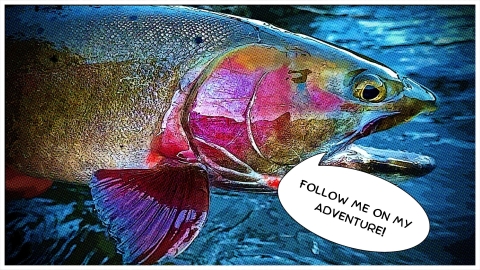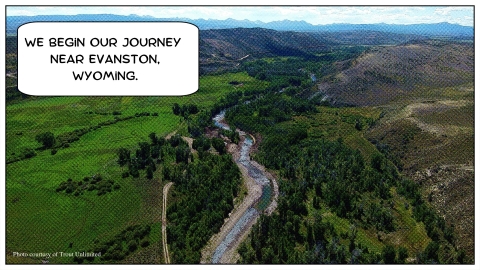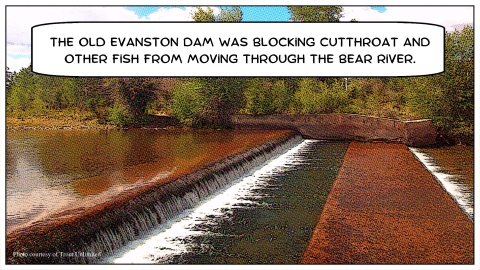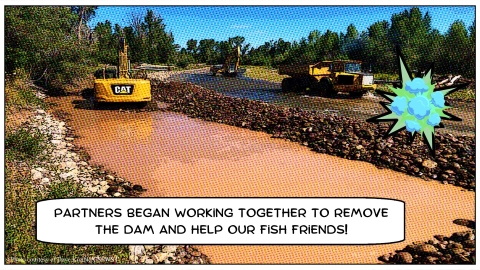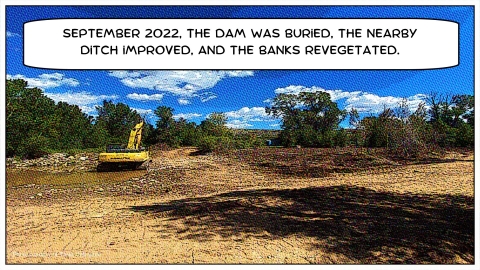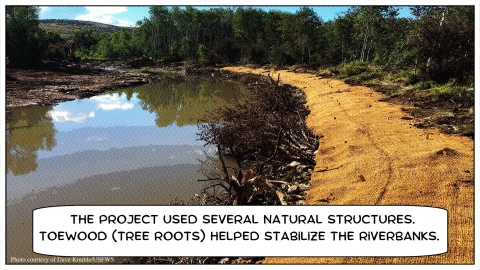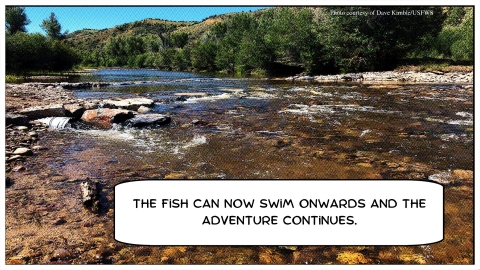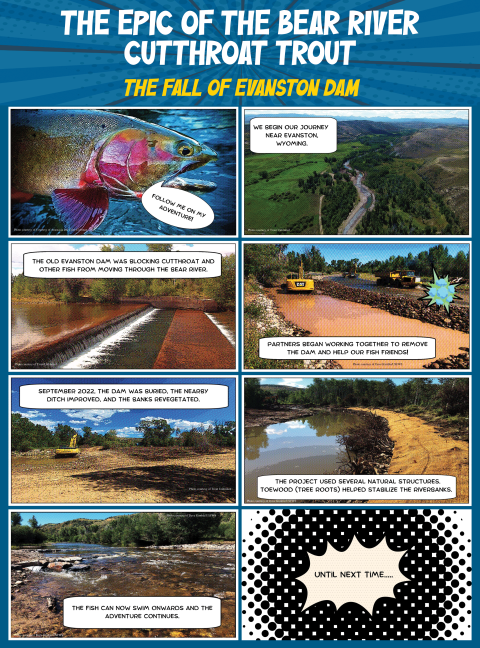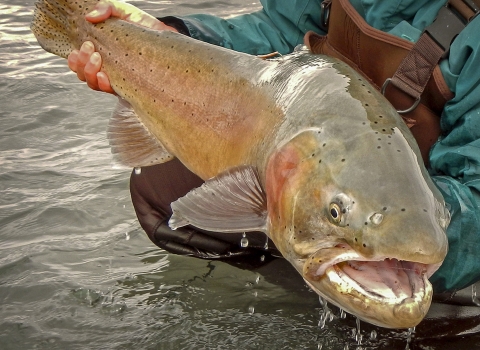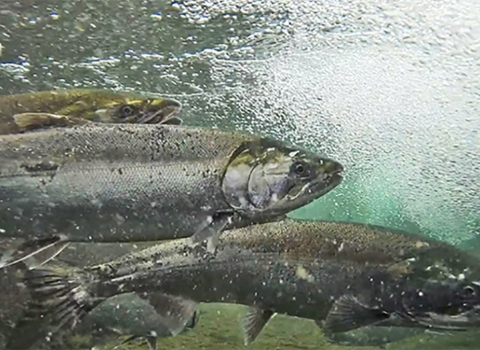Come hear a fish tale of epic scale. This is a story of the Bear River and the fish that call it home.
The Prelude
The Bear River flows from the Uinta Mountains to the Great Salt Lake, traversing about 500 miles across Utah, Wyoming, and Idaho. People and wildlife have depended on the Bear River since time immemorial. “The Bear River is the homeland of the Shoshone, it’s an ecological hotspot, and it’s an intact passage going between the Northern and Southern Rockies,” described Mike Mazur, Fishery Biologist/USFWS.
Our fishy protagonist, the not so humble Bear River Cutthroat Trout, lives within this winding river system. You may have also heard this fish go by the name of Bonneville Cutthroat Trout. “The story of cutthroat trout is the story of the evolving changes in the Western landscape. Cutthroat trout are explorers, they have a wanderlust,” explained Mazur. Bear River Cutthroat Trout live their life on the edge, whether in extreme elevations, temperatures, water flows, or surrounded by changing quantities of silt.
The ability of Bear River Cutthroat Trout to move is critical for their survival, but not everything is easy-flowing for this hero. Barriers, like dams, road culverts, and irrigation diversions, block Bear River Cutthroat Trout and other fish from moving. Climate change further underscores the need for cutthroat trout to have open pathways as they migrate to cooler water to escape the heat.
Luckily, this fish-tastic hero has some help. A partnership of federal, state, local government, NGO, and other entities have been working together for decades to restore the connectivity of the river. Therese Thompson with Western Native Trout Initiative shared, “The ongoing conservation partnership in the Bear River watershed is a great example of how many groups can come together and solve a problem in a way that’s mutually beneficial for local communities and for fish, while bolstering the long-term health of the river."
Dave Kimble, Wyoming Partners for Fish & Wildlife, also noted: “Oftentimes, a system is considered either natural or too far gone. What’s special about the Bear River is there’s a lot of issues we can address from a conservation perspective, but it’s also not so far gone.”
Now, get cozy, and prepare yourself for the o-fish-ial adventure of the Bear River Cutthroat Trout.
Where We Begin Our Journey
From 2011-2014, Trout Unlimited tracked the movement of cutthroat trout in the Bear River through a telemetry study (tracking fish via radios). Some of the tagged fish were migrating to spawn up to 45 miles in one direction – their need to move through the river undeniable.
One of the findings from the study identified a concrete dam that blocked the way of our migrating fish heroes and their unruly band of fish friends. The eroding dam stood on private property, roughly 15 miles upstream of Evanston, Wyoming. The city of Evanston used the dam to divert water, but changed its water supply source in the 1980’s. The City of Evanston and Trout Unlimited (with support from the Western Native Trout Initiative) drilled wells in 2020 for the remaining households that were using the dam and river to pull culinary water. The dam then became obsolete for human use.
Although a few of our fish protagonists were able to heroically overcome the barriers, many were getting blocked, and their journey abruptly ended.
Partners Assemble!
Various partners had been steadily working to restore connectivity to this river. For example, around the corner from the dam was the already completed Booth Ditch project.
With funds from the Bipartisan Infrastructure Law Bipartisan Infrastructure Law
The Bipartisan Infrastructure Law (BIL) is a once-in-a-generation investment in the nation’s infrastructure and economic competitiveness. We were directly appropriated $455 million over five years in BIL funds for programs related to the President’s America the Beautiful initiative.
Learn more about Bipartisan Infrastructure Law , the partnership working in the Bear River was able to undertake approximately 1,800 feet of restoration work at the Evanston Dam. The infrastructure funding helped expand the scope and scale of the work to address not one, but two fish passage fish passage
Fish passage is the ability of fish or other aquatic species to move freely throughout their life to find food, reproduce, and complete their natural migration cycles. Millions of barriers to fish passage across the country are fragmenting habitat and leading to species declines. The U.S. Fish and Wildlife Service's National Fish Passage Program is working to reconnect watersheds to benefit both wildlife and people.
Learn more about fish passage barriers simultaneously.
The project went swimmingly.
BOOM, CRASH, POOF- the dam was buried in September 2022. Practitioners opted to bury the dam, rather than fully remove it, to decrease project costs, enhance the aesthetics of the site, and increase river stability. The river was restored to its original serpentine flow across the landscape. The buildings remained as a historic reminder of the days when city staff lived on site, tasked with chipping ice to prevent the pipeline from freezing over.
The effort also included updating an irrigation diversion structure structure
Something temporarily or permanently constructed, built, or placed; and constructed of natural or manufactured parts including, but not limited to, a building, shed, cabin, porch, bridge, walkway, stair steps, sign, landing, platform, dock, rack, fence, telecommunication device, antennae, fish cleaning table, satellite dish/mount, or well head.
Learn more about structure for the Myers Ditch, which diverts one of the oldest water rights in Wyoming. V-shaped rock structures stretching across the river, known as rock cross vanes, were installed to allow for the water to be diverted without compromising the fish.
Mazur summarized the effort, “That’s the infrastructure improvement, because these structures enable the landowners to acquire water more efficiently and enable the fish to bypass those structures. It’s an upgrade to a 100+ year old system.”
The river gave in more ways than one. Using materials pulled from the re-aligned river, vegetation was installed above the buried dam. Boulders embedded in the riverbed created riffles and helped stabilize the river. The tree roots sticking out from the water along the riverbank, called toewood, were sourced from a nearby property to bolster the riverbanks and create fish habitat. Even the inconspicuous rocks on the side of the river had a role to play – intended as structures for post-runoff maintenance.
“We appreciate this opportunity to work with the City of Evanston, private landowners, water rights holders, and local construction contractors on a project that provides solutions for everyone involved, including the fish,” said Jim DeRito, Bear River Project Manager for Trout Unlimited.
Until Next Time
The river will ebb and swell but the area around the restoration project is predicted to settle after a few years. “We’re doing the project to benefit fish passage, and the landowners are trying to grow hay, but by working together there are a lot of benefits. Those irrigated meadows that they produce hay on, they have a lot of value for wetland dependent creatures like amphibians and birds. There was a huge flock of white-faced ibis that was right out there in the field supported by the water from that ditch,” highlighted Kimble.
As the years go on, the cottonwood and the willow trees will return, further reinforcing the river and reducing the need for maintenance of the site. Our fishy friends will continue in their trek up the Bear River...for now.
Tune in next month to follow the tale of the Bear River Cutthroat Trout as it swims through another fish passage barrier.
---------------------------------------------------------------------------------------------------------------


